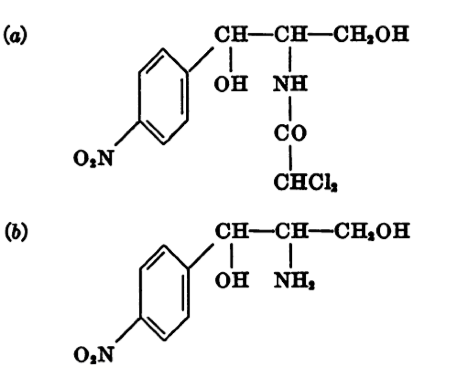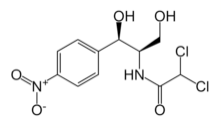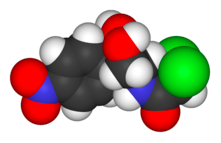Entries Tagged as 'Chloramphenicol'
Introduction | History | How It Works
Uses | Typhoid Fever | Side Effects
Synthetic Production | U.S. and the West
References
- Abbot, Evelyn (1891). Pericles and the Golden Age of Athens. New York: G. P.
Putnam’s Sons.
- Bennett, C.L., Pei, G.K., & Ultmann, J.E. (1996). Western Impressions of the Hong Kong Health
- Care System. Western Journal of Medicine, 165 (1-2). 37-42.
- Chow C.B., Wang P.S., & Leung, N.K. (1989). Typhoid Fever in Hong Kong Children. Journal of Paediatrics and Child Health, 25 (3). 147-150.
- Elsevier (2006 January 23). Typhoid Fever Led To The Fall Of Athens. ScienceDaily. Retrieved May 7, 2008, from http://www.sciencedaily.com/releases/2006/01/060123163827.htm
- Gauld, R.L., Schlingman, A.S., Jackson, E.B., Manning, M.C., Batson, H.C., Campbell, C.C. (1949). Chloramphenical (Chloromycetin) in Experimental Cholera Infections. Journal of Bacteriology, 57(3). 349-352.
- Gottlieb, D., Carter, H. E., Legator M., & Gallicchio V. (1954). The Biosynthesis of Chloramphenicol I. Precursors Stimulating the Synthesis. J Bacteriol, 68(2), 243–251.
- Gottlieb, D., Robbins, P.W., & Carter, H. E. (1956). The Biosynthesis of Chloramphenicol II.
- Acetylation of p-Nitrophenylserinol. J Bacteriol, 72(2), 153-156.
- Lam, R.F., Lai, J.S.M., Ng, J.S.K, Rao, S.K., Law, R.W.K., Lam, D.S.C. (2002). Topical
- Chloramphenicol for Eye Infections. Hong Kong Medical Journal, 8(1), 44-47.
- Leavitt, Judith Walter (1996). Typhoid Mary: Captive of the Public’s Health. Boston: Beacon Press.
- Medicinal Chemistry 412 Group 9 Webpage (2007). Chloramphenicol. Retrieved April 30, 2008, from http://sitemaker.umich.edu/medchem9/clinical_pharmacology
- Mermin, J.H., Villar, R., Carpenter, J., Roberts, L, Samaridden, A., Gasanova, L., et al. (1999).
- A Massive Epidemic of Multidrug-Resistant Typhoid Fever in Tajikstan Associated with
- Consumption of Municipal Water. The Journal of Infectious Diseases, 179. 1416-22.
- Mikkelson, Barbara (23 July 2006). Typhoid Mary. Retrieved May 2, 2008, from http://www.snopes.com/medical/disease/typhoid.asp
- Pericles (2008). In Encyclopædia Britannica. Retrieved May 7, 2008, from Encyclopædia Britannica Online: http://www.britannica.com/eb/article-5604
- Shu X.O., Gao Y.T., Linet M.S., Brinton, L.A., Gao, R. N., Jin, F. et al. (1987). Chloramphenicol Use and Childhood Leukaemia in Shanghai. Lancet, 2(8565), 934-937.
- Tatli, M.M., Aktas, G., Kosecik, M., & Abdulkadir, Y. (2003). Treatment of Typhoid Fever in Children with a Flexible-Duration of Ceftriaxone, Compared with 14-day Treatment with
- Chloramphenicol. International Journal of Antimicrobial Agents, 21. 350-353.
- Vergano, Dan (2006 January 29). Archaeologists Find Ancient Typhoid By The Teeth. USAToday. Retrieved May 1, 2008 from, http://www.usatoday.com/tech/science/columnist/vergano/2006-01-29-greek-typhoid_x.htm
- Winternitz, Carl (1952). Fatal Aplastic Anemia Following Chloramphenicol (Chloromycetin) Therapy. California Medicine, 77 (5), 335-339.
[Read more →]
Categories: Chloramphenicol
April 29th, 2008 · Comments Off on U.S. and the West
Introduction | History | How It Works
Uses | Typhoid Fever | Side Effects
Synthetic Production | U.S. and the West
References
The U.S. and the Western world have stopped using chloramphenical in its ingestible form. Only topical ointments are recommended, as for conjuctivitis.
According to Tatli et al. (2003), “approximately 16 million cases of typhoid fever occur annually in the developing world” (p. 350). The U.S. and the Western world is lucky to have the choice of whether or not to use chloramphenicol to fight a widespread epidemic. Many developing countries are afflicted with “civil war,” to suffering economies, and the deterioration of the “country’s infrastructure” (Mermin et al., 1999, p. 1416).
Of those who become victims of typhoid fever, “5%…become asymptomatic chronic carriers” (Mermin et al., 1999, p. 1416).Typhoid fever has influenced history in its shift of power in Ancient Greece and in the persecution of Mary Mallon, a woman whose nickname “Typhoid Mary” is still recognized today. History, however, has also changed medicine and the treatment of disease around the world. The ability to synthetically produce chloramphenicol has allowed underdeveloped nations to have access to an antibiotic that successfully treats typhoid fever. Its controversial side effects are changing the course of history. Some underdeveloped nations refuse to use chloramphenicol because it can cause aplastic anemia and childhood leukemia. This refusal is limiting the ability of developing nations to treat epidemics that exist and may spread due to unchanging sanitation issues. Chloramphenicol has provided the world with the hope to provide affordable healthcare to all nations of the world. The emergence of this antibiotic has made this hope a realization, and has relieved many victims of typhoid fever around the world, no matter economic circumstance.
[Read more →]
Categories: Chloramphenicol
April 29th, 2008 · 1 Comment
Introduction | History | How It Works
Uses | Typhoid Fever | Side Effects
Synthetic Production | U.S. and the West
References
Chloramphenicol was the first antibiotic to be produced synthetically in large quantities, making it cheaper than other antibiotics and widely available. Its affordability made it a lucrative asset for many third world countries affected by typhoid.
In chemistry, the synthesis of a molecule is the formation of a complex substance from simpler compounds. Due to its simple structure, chloramphenicol is simple to synthesize.
In his trials in synthesizing chloramphenicol, Gottlieb used a variety of compounds and amino acids, including:
- p-nitrophenylserinol
- dichloroacetic acid
- leucine
- isoleucine
- methionine
- tryptophan
- glutamic acid
- norvaline
- threonine
- phenylalanine
Upon further experimentation, Gottlieb discovered that p-nitrophenylserinol was the best in stimulating antibiotic production.
In this image, the structure of chloramphenicol (a) is compared to the structure of p-nitrophenylserinol (b)

This video clip is a news piece discussing the reasons why Nigerian health officials have decided against the use of chloramphenicol to treat typhoid fever.
[Read more →]
Categories: Chloramphenicol
April 29th, 2008 · Comments Off on Side Effects
Introduction | History | How It Works
Uses | Typhoid Fever | Side Effects
Synthetic Production | U.S. and the West
References
- Aplastic Anemia – condition where bone marrow does not produce enough new cells to replace blood cells. It is the most serious side effect of Chloramphenicol. It is rare and fatal because there is no treatment and no conditions of the patient to predict who will be affected. Occurs after the Chloramphenicol treatments have stopped.The risk of developing aplastic anemia following chloramphenicol therapy is “ 1/10,000” (Tatli et al., 2003, p. 350).
- Leukemia. The use of chloramphenicol can induce childhood leukemia is younger patients (Shu et al., 1987, p. 935). The “relapse rate” of typhoid fever is also considered a side effect. The “relapse rate” of typhoid fever after successfully completing chloramphenicol therapy is “approximately 10%,” making the drug less desirable even to underdeveloped countries facing typhoid epidemics (Tatli et al., 2003, p. 350).
[Read more →]
Categories: Chloramphenicol
April 29th, 2008 · Comments Off on Typhoid Fever
Introduction | History | How It Works
Uses | Typhoid Fever | Side Effects
Synthetic Production | U.S. and the West
References
Chloramphenicol’s first and foremost use globally was originally to combat typhoid fever.
Ancient Greece
Chloramphenicol was perceived as a miracle cure for the illness because of its rapid success in treating the infection. It was introduced for clinical use in the United States in 1949 after Gottlieb discovered it in a strain of Streptomyces. After this initial introduction, Chloramphenicol spread throughout the West and eventually to the eastern world.
While Chloramphenicol first appeared in the mid-20th century, typhoid fever has existed since around 430 B.C. Caused by the bacterium Salmonella enterica servoar Tyhpi, typhoid occurred in Athens as a mysterious plague. The plague killed nearly one third of the population, including the Athenian leader, Pericles. At the time of the outbreak, the people of Attica were living in tents and Long Walls, promoting poor hygiene and poor public sanitation. Typhoid is mainly transmitted by fecal contaminated drinking water (not washing hands after going to the bathroom).
Typhoid Mary

In 1907, Mary Mallon, an Irish emigrant, was identified as the first asymptomatic carrier of typhoid fever. She had come to the U.S. in 1884 and worked as a cook in New York City from 1900 to 1907. Within two weeks of working in her first household, the residents came down with typhoid fever. The next family she worked for in Manhattan also fell ill, and one member died. In the third house she work for, seven of eight residents became sick with typhoid. The next house she was a cook for in Long Island experienced six cases of hospitalized typhoid in family of eleven. Mallon also infected three households after this.
Mallon was taken into custody by the New York City Health Department and she was quarantined for three years. She was released from quarantine under the condition that she would never again work with food; Mallon did not feel obliged to heed this condition and assumed the name “Mary Brown.” By 1915, after returning to her job as a cook, now at a New York hospital, Mallon had infected 25 more people, two of whom died from typhoid. Health officials returned Mallon to quaratine. Her second time in quaratine was also her last, she committed to quarantine for life.
Upon her death, due to pneumonia, an autopsy was conducted and typhoid bacteria were found in her gall bladder. Mallon was cremated.
[Read more →]
Categories: Chloramphenicol
April 29th, 2008 · Comments Off on Uses
Introduction | History | How It Works
Uses | Typhoid Fever | Side Effects
Synthetic Production | U.S. and the West
References
• Typhoid Fever
• Gram-positive bacteria and most strains of MRSA (bacterium responsible for many human infections)
• Conjunctivitis
• Staphylococcal brain abscesses (staph infections)
• Meningitis (permitted in the West when patient has severe allergy to penicillin or cephalosporin)
• Cholera, when resistant to tetracycline (also developed from Streptomyces bacterium, but used more commonly for acne)
[Read more →]
Categories: Chloramphenicol
April 29th, 2008 · Comments Off on How It Works
Introduction | History | How It Works
Uses | Typhoid Fever | Side Effects
Synthetic Production | U.S. and the West
References
Chloramphenicol attacks bacterial cell’s ribosomes (protein creators), disturbing the cell’s ability to metabolize and synthesize new protein, and therefore killing the cell. It also stops the cell from dividing, and the immune system is then able to destroy the bacterial cell.
Chloramphenicol is unique in its structure because it “has groups… that are not usually seen in antibiotics” (“Chloramphenicol,” 2007). These groups are the dichloroacetamide group and the aryl nitro group. The aryl nitro group is of specific importance because it has been implicated as the cause of the side effect aplastic anemia. It is theorized that the aryl nitro group is “reduced to form an intermediate” and that this “intermediate… then interacts with the ferrous ion in hemoglobin and oxidizes it to a ferric state” (“Chloramphenicol,” 2007). In this ferric state, the hemoglobin will be unable to carry oxygen, causing anemia. 
[Read more →]
Categories: Chloramphenicol
April 29th, 2008 · Comments Off on History
Introduction | History | How It Works
Uses | Typhoid Fever | Side Effects
Synthetic Production | U.S. and the West
References
In 1947, professor of plant pathology at the University of Illinois David Gottlieb isolated a strain of Streptomyces (a bacteria found in soil), from which Chloramphenicol was developed.
Chloramphenicol was introduced into clinical use in 1948.
Chloramphenicol was seen, upon its discovery, as a near-perfect drug.
• It could be given orally, and at home
• Because of it high pH, it is able to penetrate purulent material (material containing pus), and through cell membranes to parasites and into organs that other antibiotics could not reach
[Read more →]
Categories: Chloramphenicol
April 29th, 2008 · 1 Comment
Introduction | History | How It Works
Uses | Typhoid Fever | Side Effects
Synthetic Production | U.S. and the West
References


For nearly 2500 years, cases of typhoid fever have been documented around the world. From the epidemic’s origins in Greece, to its appearance in the industrializing United States, and finally to its current presence in underdeveloped nations, typhoid has become a problematic illness. The disease is easily prevented and well-treated, but in areas of the world that suffer from poor economies or unsanitary conditions, typhoid is a common occurrence and often leads to permanent health problems or death. In the past century, however, the creation of many antibiotics has enabled wealthy countries, like the United States, to combat the disease, and new medical technology has allowed these drugs to be reproduced for the masses.
Chloramphenicol, one of the first antibiotics used to treat typhoid fever, is one drug that is produced synthetically today. Because it is produced synthetically, chloramphenicol is readily available to under-developed nations who are in desperate need of a treatment for typhoid. The drug, however, has recently become controversial because of its dangerous side effects, which could result in the development of rare and untreatable illnesses such as leukemia and aplastic anemia. Due to the possibility of these very serious side effects, many underdeveloped countries have decided to cease the use of chloramphenicol to treat typhoid fever.
[Read more →]
Categories: Chloramphenicol
April 28th, 2008 · Comments Off on Chloramphenicol
Categories: Chloramphenicol





